
About UsThe Numismatic Bibliomania Society is a non-profit organization promoting numismatic literature. For more information please see our web site at coinbooks.org SubscriptionsThose wishing to become new E-Sylum subscribers (or wishing to Unsubscribe) can go to the following web page link MembershipThere is a membership application available on the web site Membership Application To join, print the application and return it with your check to the address printed on the application. Membership is only $15 to addresses in the U.S., $20 for First Class mail, and $25 elsewhere. For those without web access, write to: David M. Sundman, Secretary/TreasurerNumismatic Bibliomania
Society AsylumFor Asylum mailing address changes and other membership questions, contact David at this email address: dsundman@LittletonCoin.com SubmissionsTo submit items for publication in The E-Sylum, just Reply to this message, or write to the Editor at this address: whomren@coinlibrary.com
BUY THE BOOK BEFORE THE COINYou won't regret it! |
- WAYNE'S WORDS: THE E-SYLUM FEBRUARY 21, 2010
- E-SYLUM HOUSEKEEPING ISSUES
- NEW BOOK: ROCHESTER NUMISMATIC ASSOCIATION MEDALS BY TIMOTHY CORIO
- NEW BOOK: CURIOUS CURRENCY BY ROBERT D. LEONARD
- NEW BOOK: GUIDE BOOK OF UNITED STATES COINS, 64TH EDITION (2011)
- NEW BOOK: WHAT TO DO WITH GRANDDADDY'S COINS
- BOOK REVIEW: CATALOGUE OF NEW ZEALAND COMMEMORATIVE MEDALS 1941-2007
- BOOK REVIEW: CATALOG OF BANKNOTES OF THE CIVIL WAR IN RUSSIA, VOLUME 3
- THE U.S. MINT'S "FIRST FAMILY" - THE ECKFELDTS
- COLONIAL NUMISMATIC BIBLIOGRAPHY PLANNED
- TWO MAJOR FRENCH NUMISMATIC MUSEUMS SET TO CLOSE
- MORE ON THE EARLIEST FIVE-POINTED STAR ON A U.S. COIN
- MORE ON THE CHROME CENTS OF 1954
- QUERY: TERM FOR PAPER PRESSED INTO COIN FORM SOUGHT
- MORE ON THE 2010 WINTER OLYMPIC MEDALS
- SUBSCRIBER PROFILE: LUKE GRIFFIN
- THE SOUTH DAKOTA HUDSON'S BAY COMPANY TOKEN HOARD
- 1974 CARSON CITY DOLLAR GSA SALE PRESS KIT SOLD
- DICK JOHNSON: WHY THE U.S. MINT SHOULD CEASE STRIKING CENTS
- THE 2010 LINCOLN CENT SHIELD REVERSE DESIGN
- WILLIAM HARNETT, ENGRAVER AND TROMPE L'OEIL PAINTER
- THE COLLECTORS WEEKLY
- THE BANKNOTE MUSEUM OF GREECE
- ANCIENT COIN COLLECTORS GUILD SUES U.S. GOVERNMENT
- OLD SILVER RUPEE COINS STILL USED IN MYANMAR ENCLAVES
- CINCINNATI GOLD EXHIBIT
- SOUTH CAROLINA LEGISLATOR WANTS TO OUTLAW FEDERAL RESERVE NOTES
- THE ONION: NATION REALIZES MONEY JUST A MUTUALLY SHARED ILLUSION
- FEATURED WEB SITE: THE COINS OF MALTA
WAYNE'S WORDS: THE E-SYLUM FEBRUARY 21, 2010

Among our new subscribers this week are William B. Mills, courtesy of Howard Daniel, Luke Griffin, and Jason O'Grady. Welcome aboard! We now have 1,331 subscribers.
NBS web master Bruce Perdue also serves as the webmaster for the Central States Numismatic Society (CSNS). He's a dependable as the sun rising in the morning, and we can always count on him to keep our web site and E-Sylum archive up-to-date. He has thrown his hat in the ring to run for Governor of CSNS. Good luck in the election!
New subscriber Luke Griffin writes:
I just finished reading the entire newsletter from Sunday. What a wonderful publication and group you have going. Even though there was a lot in there about American coins, of which I know almost nothing, I found each article fascinating, and enjoyed going to some of the web sites that were mentioned.
Ray Williams writes:
I sent another blurb to the colonial coin chat group about subscribing to The E-Sylum, like I do several times a year. Hopefully some will take my advice. Not subscribing to The E-Sylum is like seeing a $50 bill on the ground and walking by without picking it up! Thanks for all you do here!
Thanks for the kind words. It's always fun to put together these issues - E-Sylum readers are the best folks around, and there is never any shortage of interesting numismatic topics to discuss.
This week we open with SIX new book announcements and reviews, followed by some great news from Len Augsburger and Joel Orosz on their research into the first Philadelphia Mint.
Other topics this week include chromed cents, paper coins, a hoard of Hudson's Bay Company tokens and William Harnett. To learn about chrome cents, woodpecker scalps, and an epiphany on the value of money, read on.
Wayne Homren
Numismatic Bibliomania Society
E-SYLUM HOUSEKEEPING ISSUES
Odd Characters
Jim Duncan and other readers have reported the appearance of an odd-looking character in their E-Sylum issues, but they weren't referring to my picture. This is a known problem that should be corrected in the current issue. To prevent these I regularly substitute tricky characters like slanted single and double quote characters with simple straight ones. But two weeks ago something happened to my replacement process and some of the crazy characters were sneaking through.
Bounced message email
And no one else has reported this, but some of you have been seeing email messages like this one I'm been getting:
Your membership in the mailing list Esylum has been disabled due to excessive bounces The last bounce received from you was dated 11-Feb-2010. You will not get any more messages from this list until you re-enable your membership. You will receive 2 more reminders like this before your membership in the list is deleted.
To re-enable your membership, you can simply respond to this message (leaving the Subject: line intact), or visit the confirmation page at ....
You can also visit your membership page at ...
These are legitimate emails, but if you get one, DON'T visit the confirmation page - it won't work. It's a known bug that the Binhost people are aware of, and it should go away with the next upgrade of the mailing system. Instead, use one of the other two methods to refresh your subscription.
The E-Sylum Archive
And don't forget that every single issue and article published in The E-Sylum is archived on our web site and searchable via Google. Visit the archive anytime at this address:
www.coinbooks.org/club_nbs_esylum_archive.html
.
NEW BOOK: ROCHESTER NUMISMATIC ASSOCIATION MEDALS BY TIMOTHY CORIO
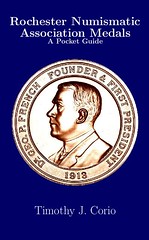 The Rochester Numismatic Association has been issuing medals since 1913.
My new book Rochester Numismatic Association Medals - A Pocket Guide is the first commercially available listing of these medals.
The Rochester Numismatic Association has been issuing medals since 1913.
My new book Rochester Numismatic Association Medals - A Pocket Guide is the first commercially available listing of these medals.
The RNA is the second oldest continuously meeting numismatic club in the US. Its medals record important events in the club's and the community's histories. Most of the medals were designed by RNA members including sculptor/medalists Joseph A. Koeb and Alphonse A. Kolb.
The book is available at Lulu.com where the entire content can be previewed. The cost is $9.95 plus tax and shipping. Search for "Rochester Numismatic" in Lulu.com's search box or go straight to
www.lulu.com/product/paperback/rochester-numismatic
-association-medals---a-pocket-guide/6346903
NEW BOOK: CURIOUS CURRENCY BY ROBERT D. LEONARD
 In Curious Currency you'll join award-winning author Robert D. Leonard as he trots the globe exploring the development of money from the Stone Age to the Internet Age. You'll find a treasure trove inside this colorful, entertaining, and authoritative book: gold, silver, and blocks of salt. . . elephant tails, Yap stones, and chocolate bars. . . iron nails, whale teeth, human skulls, and hundreds of other pieces of odd and curious money. Each has a fascinating story. Each holds a lesson for anyone who earns, spends, or collects money today.
In Curious Currency you'll join award-winning author Robert D. Leonard as he trots the globe exploring the development of money from the Stone Age to the Internet Age. You'll find a treasure trove inside this colorful, entertaining, and authoritative book: gold, silver, and blocks of salt. . . elephant tails, Yap stones, and chocolate bars. . . iron nails, whale teeth, human skulls, and hundreds of other pieces of odd and curious money. Each has a fascinating story. Each holds a lesson for anyone who earns, spends, or collects money today.
Kenneth Bressett, longtime editor of the internationally best-selling Guide Book of United States Coins, praises Leonard's "fresh approach to understanding the nature of money," calling his book "an entertaining overview" and "a provocative study."
Award-winning author Q. David Bowers also has glowing words for Curious Currency. "Bob Leonard's magnificent book is the ‘missing link' in publications in our hobby," Bowers says. "We know about silver dollars, Gold Certificates, Pine Tree shillings, and ancient decadrachms, but odd and curious money is equally important and fascinating. Curious Currency brings it all to life—clam shells, slave girls, woodpecker scalps, and other unusual monies. Congratulations to Bob Leonard on a job well done."
Richly illustrated with full-color photographs and drawings, and handsomely bound in hardcover, this 160-page book is a wonderful bargain at $12.95. It's a great way to get kids interested in collecting. . . a serious compendium for the student of numismatics. . . and a fun read for anyone interested in that ancient and always popular topic, MONEY!
Curious Currency appeals to both casual readers and experienced collectors. It is fully indexed, with copious notes and bibliography for further research. The book will be available in March 2010, online and at bookstores and hobby shops nationwide. Hardcover, full color, 160 pages, $12.95.
To read the complete article, see:
Money: From the Stone Age to the Internet Age
(www.whitmanbooks.com/Default.aspx?
Page=55&HTMLName=ReviewUpcoming_0210)
NEW BOOK: GUIDE BOOK OF UNITED STATES COINS, 64TH EDITION (2011)
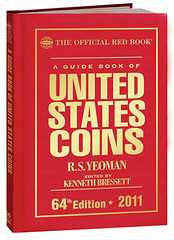 The 2011 (64th) edition of the Guide Book of United States Coins (known to collectors as the "Red Book") includes many new features, plus dozens of additions to the book's 1,800-plus color photographs. The new edition, available April 2010, can be found online (including at WhitmanBooks.com) and in bookstores and hobby shops nationwide.
The 2011 (64th) edition of the Guide Book of United States Coins (known to collectors as the "Red Book") includes many new features, plus dozens of additions to the book's 1,800-plus color photographs. The new edition, available April 2010, can be found online (including at WhitmanBooks.com) and in bookstores and hobby shops nationwide.
"The hobby has been very active, and as always the Red Book reflects that activity," said longtime editor Kenneth Bressett. He cited as an example the "Bullion Values of Gold Coins" in appendix C. "In the 63rd edition we charted gold from $675 to $1,100. Because gold has been so active, affecting many areas of the hobby, this year we've charted it from $925 to $1,450."
Sections that have additional photographs include Lincoln cents, Capped Bust dimes, Morgan dollars, Washington quarters, modern dollars, and commemoratives. The "Misstrikes and Errors" appendix includes new photographs including a clipped-planchet Liberty Head nickel; a multiple-strike Pennsylvania state quarter; Washington quarter and Lincoln cent cuds; an off-center Flying Eagle cent; and a Franklin half dollar struck on a nickel planchet.
A section that has seen expansion with additional information is "Pre-Federal Issues," which covers colonial and post-colonial coins and tokens as well as Continental dollars and other early contract issues and patterns. "The colonial and Revolutionary eras are rich fields for exploration," said Red Book research editor Q. David Bowers, whose Whitman Encyclopedia of Colonial and Early American Coins won "Best Specialized Book of the Year, U.S. Coins" from the Numismatic Literary Guild. Because so many new hobbyists are starting to collect these early American coins, the 64th-edition Red Book has expanded its pricing in lower- to middle-range grades. "Good and Very Good are popular collectible grades for these old coppers, and affordable for the beginner," Bowers noted. The 64th edition includes 110 more pre-federal prices than the 63rd, in addition to text updated with recent research.
In the "Commemoratives" section, the 64th edition includes new photographs, as well as information on the latest U.S. Mint offerings, and updated mintage data. In addition, classic commemoratives are now priced up to grade MS-66. "The 63rd edition stopped at MS-65," said Red Book valuations editor Jeff Garrett, "but many serious collectors seek the classic commems of 1892 to 1954 in higher Mint State grades." The addition of the higher-grade pricing covers 109 early commemorative coins and sets.
The "Bullion" section includes updated information and photographs for the U.S. Mint's latest issues, including, for the first time, a listing for the 2008W burnished American Silver Eagle with the reverse of 2007. "This is a variety that has excited modern-coin and bullion collectors," said editor Bressett. "It's easily discernible to the unaided eye, and it represents a significant design variety. We've been watching its market activity and collector interest, and decided it's time to include it in the Red Book."
New content has been added to cover the 2009 Lincoln cent designs, the 2010 "Union Shield" reverse cent, the Native American "Great Law of Peace" dollar, National Park quarters, Presidential dollars, and First Spouse gold bullion coins. Mintage figures have also been updated as currently as possible with official data from the U.S. Mint.
In addition to the 64th Red Book's nearly 33,000 individual coin prices in up to nine grades per series, Appendix D showcases the Top 250 Auction Prices for U.S. coins.
"To keep up with modern coins, we've added pages to Small Cents; Silver and Related Dollars; Commemoratives; and Bullion," said Whitman publisher Dennis Tucker. "With each new Red Book, we look for ways to make small but valuable editorial improvements. For example, in the 64th edition's table of contents, we've inserted date ranges for each coin type. This might seem minor to an experienced collector, but it's very helpful and informative for beginners."
Appendix B, "Collectible Red and Blue Books," has been expanded with more details, including more pricing for early Blue Books. Coverage of recent collectible Red Books includes the 2010 Large Print Edition, and the limited-print-run Philadelphia Expo edition (valued at $50).
The Red Book's numismatic bibliography continues to be updated with current literature, to aid in further research. Its 129 listings include more than a dozen references published from 2008 to 2010.
432 pages
Full color
By R.S. Yeoman; edited by Kenneth Bressett
$14.95 spiralbound
$16.95 hardcover
$19.95 spiralbound hardcover
$29.95 Large Print Edition
$69.95 leather-bound Limited Edition (1,500 copies)
For more information, or to order, see: 2011 Red Book U.S. Coins Hard Cover (www.whitmanbooks.com/Default.aspx?Page=81&ProductID=0794831486)
NEW BOOK: WHAT TO DO WITH GRANDDADDY'S COINS
Jessica Mullenfeld of Zyrus Press writes:
We just had a new book come out yesterday, What to do with Granddaddy's Coins by Jeff Ambio. It's a beginner's guide to identifying, valuing and selling old coins.
Now available, What to do with Granddaddy's Coins is the essential tool needed to take advantage of the present lucrative numismatic trade. Beginners have been awaiting the arrival of this ideal handbook to learn how to get the most favorable profit from miscellaneous coins in today's cutthroat market. Written with the non-coin collector in mind, this book guides the reader to identify coins and their values, and advises what to do with them without risking the loss of a great reward.
Numismatic expert Jeff Ambio provides direct and impartial counsel to readers on how to confidently discuss their coins, effectively work with dealers/auction houses and make sensible decisions when the time comes to sell. All the basics of dealing with old coins are covered in this comprehensive guide.
- A chapter discussing needed supplies
- How to properly care for coins without risk of devaluing them.
- What makes a coin valuable in today's numismatic market.
- What to expect when working with dealers and auction houses.
Ideal for anyone who has come into a coin collection, this book is the only one on the market written for non-collectors to gain the most advantageous benefits from their coins. Currently available, What to do with Granddaddy's Coins is a helpful resource for the non-collector who has acquired a potentially valuable inheritance.
BOOK REVIEW: CATALOGUE OF NEW ZEALAND COMMEMORATIVE MEDALS 1941-2007
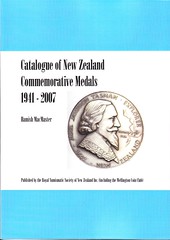 Hamish MacMaster's new Catalogue of New Zealand Commemorative Medals 1941-2007
Hamish MacMaster's new Catalogue of New Zealand Commemorative Medals 1941-2007
Ever since the publication of Leon Morel's seminal catalogue of Medallic Commemoratives of New Zealand, covering the first 75 years of such issues (1865-1940) (1976, 2nd ed. 1996 and supplement in 2000), collectors have bemoaned the absence of a comparable volume covering the post-1940 period.
For the past eight years or so, Hamish MacMaster and I (mainly Hamish) have been contributing articles on our researches into post-1940 medals to the NZ Numismatic Journal, partly in the hope that it would make the information more readily available to whoever took up the much greater task in due course.
In the end, Hamish did so himself, compiling information from our articles and his own extensive collection, as well as details supplied by other collectors and those gleaned from primary sources and earlier numismatic publications, to produce a book whose scope rivals that of its earlier companion. The new Catalogue of New Zealand Commemorative Medals 1941-2007, published by the Royal Numismatic Society of New Zealand in December 2009, lists over 400 commemorative medals by date, with appendices for undated/unattributed issues, collector series, wooden medals, "challenge coins", etc.
Most medals are illustrated, and all are described in full detail, which in some cases makes up for images that are not as sharp as we might have preferred – images of some medals that we could not photograph directly were "as supplied" or drawn from earlier Society publications, photocopied newsletters, etc., and for some medals the final image resolution is lower than anticipated.
The "rarity scale" used by Morel has been dropped as, in many instances, original mintages are known, or not enough examples have been seen in trade to permit a reasonable estimation of rarity. Significant recent sale prices have been included for some earlier issues in particular, and issue prices are recorded where known. Otherwise the entries are unpriced.
If I dare say so myself as editor for this project, it's a must for NZ collectors in particular, and numismatic bibliophiles in general, as the first attempt at a comprehensive listing of commemorative medals struck in or for this country since 1940. Popular lore had it that the post-1940 period was "dead" for the commemorative medal; Hamish has definitively put an end to that myth.
Specifications: 206pp, A4 format. Soft cover (laminated). Soft cover print run limited to 400. ISBN 978-0-473-15585-8. Order from the RNSNZ, PO Box 2023, Wellington 6140, NZ, or e-mail hamish.macmaster@mfat.govt.nz
Prices: NZ$45 ea. delivered in NZ. Overseas: AUD50, US$45, £30 incl. p+p.
BOOK REVIEW: CATALOG OF BANKNOTES OF THE CIVIL WAR IN RUSSIA, VOLUME 3
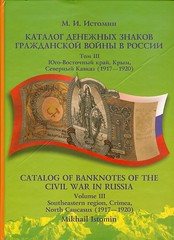 Mikhail Istomin's much heralded work titled Catalog of Banknotes of the Civil War in Russia has recently taken another giant step forward with publication of his Vol. 3. This time he has covered the Southeastern Region, Crimea and North Caucasus, 1917-20.
Mikhail Istomin's much heralded work titled Catalog of Banknotes of the Civil War in Russia has recently taken another giant step forward with publication of his Vol. 3. This time he has covered the Southeastern Region, Crimea and North Caucasus, 1917-20.
Recapping briefly, Vol. 1, published in 2006, dealt with North and Northwestern Russia, Baltics, Central Russia and Byelorussia. This initial book contained 242 pages. Two years later the second volume with information on Ukraine 1917-20 and Western Ukraine 1914-19 was released. It was larger, with a total of 413 pages. It was thus a surprise to see that the present third volume came out only one year later. The first two have been reviewed in this column; now I want to concentrate on the newest of this planned seven-volume set. All three published so far have a number of full-color note images of issues pertaining to that particular volume on the inside front and back covers. Those notes shown on the inside are not in color.
Vol. 3 is the biggest so far written, as it contains 582 pages. All text is presented as before in both Russian and English, making the book quite easy to follow. The first section starts out with pages of text explaining in some detail the background behind Cossack issues of the "White South." There follow the broadly based issues of Rostov-on-the-Don and Southern Russia. Listings include many varieties, all with either estimates of value or dash lines. Illustrations are all marked with reference numbers for ease of identification in the listings.
The scope of this many-volume work appears very wide, with coverage of so many kinds of issues that it is virtually unbelievable. It is such a historic time for Russia and the world that it fully merits such a study. For the numismatist interested in this area of collecting it is a bonanza of tremendous proportions.
For my own reasons I wish Istomin had also provided full coverage of the business and private issues as well, though they are probably not so well known or documented. The only way we can find out what exists is to publish what we know and watch the additions and corrections flow in, as they almost invariably do.
If you would like to purchase a copy of this latest book or the earlier volumes, you may address Istomin through his e-mail address: istomin1956@rambler.ru. Cost of Vol. 3 will be around $60.
To read the complete article, see: Vol. 3 of Russian Civil War Issues Available (www.numismaster.com/ta/numis/Article.jsp?ad=article&ArticleId=9460)
THE BOOK BAZARRE
THE U.S. MINT'S "FIRST FAMILY" - THE ECKFELDTS
Below is their report along with images of some photos from the Eckfeldt family archive. It's a delight to learn that these materials have survived over a century and are being made available to authors. If Neil Shafer is the "Indiana Jones" of numismatic research, then this dynamic duo are Lord Carnarvon and Howard Carter, discoverers of King Tut's tomb. Congratulations! We bibliophiles will await publication of further details. -Editor
Joel Orosz and Len Augsburger had the privilege of spending two days this week with a descendant of Adam Eckfeldt who resides on the East Coast. The extended family is very aware of their numismatic legacy and has done an outstanding job of preserving Eckfeldt memorabilia throughout the years.
We present here a number of images of family members taken from the collection. Adam of course was the patriarch, serving as chief coiner in the first United States Mint. Later, son Jacob R. and grandson Jacob B. worked in the Assay Department. Jacob B.'s letter of resignation was dated 1929 - representing a remarkable span of over 130 consecutive years of service to the U.S. Mint. William E. DuBois married a daughter of Adam Eckfeldt and both William and his son Patterson served in the Mint Assay Department.
Additional photographs and ephemera from the Eckfeldt Collection will be presented in Orosz and Augsburger's forthcoming work, "Pictures of the First United States Mint: The Numismatic Legacy of Frank H. Stewart." Stewart carried on a lively correspondence with Jeanette Eckfeldt, the wife of Jacob B. Eckfeldt, and attended Eckfeldt's 50th year of service celebration in 1915. A silver cup donated on that occasion by Eckfeldt's coworkers remains in the family, as do many other interesting items.

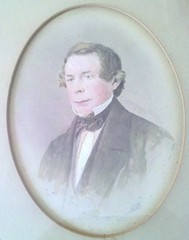
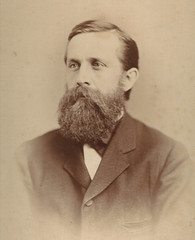
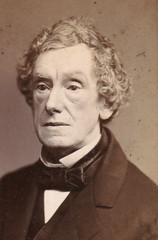
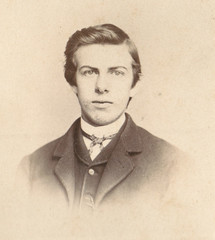
- Uniface impression in brass of the Adam Eckfeldt (Julian MT-18) retirement medal
- Watercolor portrait of Jacob R. Eckfeldt
- Photographic portrait of Jacob B. Eckfeldt
- Photographic portrait of William E. DuBois
- Photographic portrait of Patterson DuBois
COLONIAL NUMISMATIC BIBLIOGRAPHY PLANNED
With respect to your observation about the Colonial Numismatic Literature Survey not having a short description about each of the items, our next project is to write Colonial Numismatic Bibliography. Years ago, Mary Sauvain had written one, Ray Flanigan had later expanded on it, and one or two others have also dabbled in this area.
Colonial numismatics covers such a large number of different specialty areas, and I expect that this will be a large project that could possibly be the size of a book at some point. Certainly though, we can assemble a list of recommended books, catalogs and websites that we can have posted on our website. It is my hope that Steve Frank will continue with what he started with the survey, and head the project to assemble the Colonial Numismatic Bibliography
To read the earlier E-Sylum article, see: COLONIAL NUMISMATIC BOOK AND CATALOG SURVEY PUBLISHED (www.coinbooks.org/esylum_v13n07a10.html)
TWO MAJOR FRENCH NUMISMATIC MUSEUMS SET TO CLOSE
Hadrien Rambach writes:
The Cabinet des Médailles et Antiques in Paris is a first rank Museum which preserves French National Treasures (Merovingian Kings Childeric's Weapons and Dagobert's Throne, the so-called Charlemagne's Chessmen, etc.). It has been enriched till nowadays through many acquisitions and bequests (Count Caylus, Duke de Luynes, Schlumberger...).
It is one of the very first collections of the World in Greek Ceramics, Cameos and Coins, as well as Marble, Bronze, Ivories... But, shamefully, if nothing is done, this centuries-old Museum will come to an end. To learn more about it, please have a look at our website.
Help us to save the Museum, broadcast these news, sign here : jesigne.fr/sauvonsleplusancienmuseedefrance ...and come and visit us.
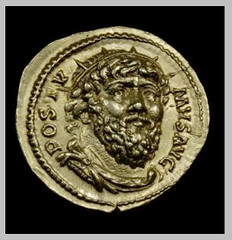
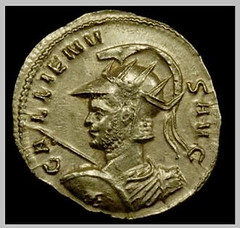
Colin Bruno writes:
TWO major French numismatic museums are going to close: le Muse de la Monnaie de Paris (French Mint Museum) which will be closed by the end of June, and Cabinet des Medailles de la Biblioteque National (National library). Please find herewith links with French magazines about that.
 Cabinet is derived, like the Louvre, the royal collection. It was mainly coins, medals, cameos and intaglio and various objects of curiosity. The estate inventory of Charles V was already collecting about 4,000 works, and many kings continued to expand, including Francis I and Louis XIV. This latest collection installation at the Louvre, before transferring the Rue Vivienne in 1666 and then to Versailles in 1684. It was under Louis XV, in 1720, the Cabinet finally returned to the Royal Library
Cabinet is derived, like the Louvre, the royal collection. It was mainly coins, medals, cameos and intaglio and various objects of curiosity. The estate inventory of Charles V was already collecting about 4,000 works, and many kings continued to expand, including Francis I and Louis XIV. This latest collection installation at the Louvre, before transferring the Rue Vivienne in 1666 and then to Versailles in 1684. It was under Louis XV, in 1720, the Cabinet finally returned to the Royal Library
On 23 January, before the French Committee of Art History, Jacqueline Sanson, Director General of the BNF, explained that the museum would "not be maintained and that the showrooms of the current Cabinet of Medals will exist more. It merely confirmed in public that leaders of the National Library had argued internally for several weeks.
1. The museum will no longer exist as such, although the Cabinet of medals remain for the consultation of researchers.
2. The works will be almost entirely retained in reserve.
3. Only the room Luynes, that this part of the collection bequeathed by the Duke of Luynes (including important Greek vases), and whose presentation is a requirement of the legacy will be preserved and accessible to the public.
To read the complete article, see:
Museums in danger
(www.latribunedelart.com/musees-en-danger-2-le-cabinet
-des-medailles-de-la-bibliotheque-nationale-article002433.html)
MORE ON THE EARLIEST FIVE-POINTED STAR ON A U.S. COIN
Mark Borckardt writes:
I expected someone to mention the Barber coins. The 1792 half disme is sort of a gray area, as some call it a pattern and others a regular issue. I personally agree that it is a regular issue, but it wasn't produced at the physical Mint building.
The Starred Reverse cent is a great choice and one that I had managed to overlook as my initial recollection was that they were six pointed stars. Reexamination shows that they are indeed five pointed stars. Thanks to Bob Hewey for his observations.
To read the earlier E-Sylum article, see: THE EARLIEST FIVE-POINTED STAR ON A U.S. COIN? (www.coinbooks.org/esylum_v13n07a11.html)
MORE ON THE CHROME CENTS OF 1954
Regarding Tom Kays' item about the chrome cents of 1954, Tom DeLorey writes:
Either somebody chromed a bunch of coins as a legitimate (albeit illegal) tax protest of some sort, or some coin dealer thought up a clever way to get people to come into their shop at the cost of a mere two cents per response.
Dave Lange writes:
Regarding the chrome pennies, a clue is found in the phrase "Wagner Tax Protest Pennies." Robert F. Wagner was mayor of New York City 1954-65, and it's likely that his administration imposed a one-cent tax for some reason. The theater's management evidently had a bunch of cents chrome-plated to protest this new tax.
In those days the Treasury and Secret Service were overly cautious and pedantic when it came to any alteration to our coins, routinely denying to collectors that any mint errors or varieties were genuine. The forces of authority must have bullied the theater into recalling all of the plated coins. It seems likely that the theater received more publicity from the recall than from the original issuance.
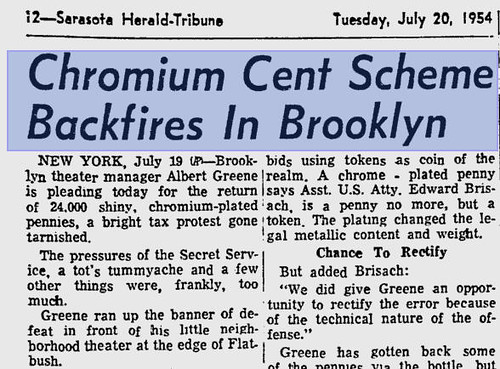
To read the complete article, see:
Chromium Cent Scheme Backfired in Brooklyn
(news.google.com/newspapers?nid=1755&dat=
19540720&id=vXUjAAAAIBAJ&sjid=sL4EAAAAIBAJ&pg=1589,3006979)
To read the earlier E-Sylum article, see: QUERY: THE CHROME PENNIES OF 1954 (www.coinbooks.org/esylum_v13n07a13.html)
QUERY: TERM FOR PAPER PRESSED INTO COIN FORM SOUGHT
Gar Travis is one of our regular "answer guys", but this time he poses a question for our readers:
The siege of the city of Leyden, in modern day Netherlands, is believed to be the first instance wherein paper money of necessity was used. Although Leyden boasts a wide variety of metallic siege coins from the 1570s, it was here that the first paper siege notes were issued. These "notes" are not notes at all but are, more properly, considered coins. When besieged Leyden exhausted its supply of silver, the coins were made of paper torn from prayer books. Resembling the real thing, this money, struck from coin dies, nevertheless was made of paper.
Are these items coins or paper money? The controversy could go on forever. Being a paper money enthusiast, I prefer to view them as paper money, and offer in support of my thesis the dictionary definition of a "coin". Trusty Mr. Webster defines a coin as: " a flat round piece of metal issued by government authority as money", or, "metal money". Since these "coins" are not metal, they must be considered "paper", or so my logic goes!

Metalic siege money of Leyden (left), struck in 1574 from a round coin die onto a diamond shaped silver planchet. As the supply of silver available for coinage dried up during the siege, Leyden continued to mint coins made from paper torn from prayer books. These cardboard "notes" became the first paper money to appear in the Western world. Prior to this only the Chinese used paper money.
A cardboard coin struck during the Spanish siege of Leyden in 1574 may be seen at right. The arms consist of a rampant lion with shield and sword. Note the counterstamp located at six o'clock. By order of Prince William of Orange, provincial counterstamps were added to all coins in excess of 1/10 daalder. This act increased the value of the coinage in circulation by one eighth, which was then used as a war contribution.
There are eight known specimens of Leyden cardboard money made from coinage dies. They range in value from 5 to 30 stuivers. All are dated 1574. Some bear countermarks while others do not. A listing of these pieces follows:
- 5 stuiver 1574 30mm Crowned lion with shield and sword, Legend: "Pugno Pro Patria", With and without countermark.
- 14 stuiver 1574 Description not available.
- 16 stuiver 1574 Description not available.
- 18 stuiver 1574 Description not available.
- 20 stuiver 1574 37mm Crowned lion with liberty cap on pole. Obverse legend: "Haec Libertatis Ergo", Reverse legend: "Godt behoedeLeyden"
- 20 stuiver 1574 37mm Crowned lion with standard, legends as above. With and without countermark.
- 28 stuiver 1574 43mm Crowned lion with sword and shield Legends as above.
- 30 stuiver 1574 48mm With and without countermark.
MORE ON THE 2010 WINTER OLYMPIC MEDALS

I just read the article on the Olympic Medals in the 14 February 2010 issue of The E-Sylum. I thought your readers might like to visit two more sources for more first-hand info on the medals:
First is the Royal Canadian Mint's website at www.mint.ca, and click on the "Learn" tab and then on "Vancouver 2010". As the designer and maker of the medals, the Royal Canadian Mint provides lots of hi-res photos, information and a video on the making of both the Olympic and Paralympic medals.
As well, the official website for the games at www.vancouver2010.com has info, but it is not easy to find, so here are some links for your readers:
A video:
www.vancouver2010.com/olympic-videos/
the-medals_173592g110288-ah.html
VANOC news release:
www.vancouver2010.com/olympic-news/n/news/vancouver-2010-medals
-each-a-one-of-a-kind-work-of-contemporary-aboriginal-art-_170092ID.html
VANOC article "Meet the Medals":
www.vancouver2010.com/olympic-news/meet-the-medals_170520rk.html
All the best from the Great White North!
To read the earlier E-Sylum articles, see:
DESIGNING THE 2010 WINTER OLYMPIC MEDALS
(www.coinbooks.org/esylum_v13n07a21.html)
MAKING THE 2010 OLYMPIC MEDALS AT THE ROYAL CANADIAN MINT
(www.coinbooks.org/esylum_v13n07a22.html)
SUBSCRIBER PROFILE: LUKE GRIFFIN
I am the director of a religious non-profit publisher and we are interested in publishing a series of bookmarks, posters, and a Bible study book all on the topic of Biblical coins. I have been interested in Biblical coins for years as well as ancient numismatics as a whole.
While I have a fairly nice collection of these coins, I am missing a few of the pieces that would be needed to put together the publications we would like to produce. I found this group online, and contacted Wayne. He suggested that I send out a call for help to the group. So, if any of you have nice photos of the following coins, I would love to use them in our publications.
I have found a couple of great sources, but the cost is prohibitive. Being a non-profit, I cannot afford a lot. If anyone would like to let us use your high resolution coin photos we might be able to afford a small payment, and we would of course give you credit, and advertising if you are a dealer.
I am looking for good photos of the following coins:
- Golden Daric
- Any coin of Herod the Great
- Any of Herod Antipas
- Tiberius Denarius (known as the "Tribute Penny")
I think I have the rest of what I need, and am doing experiments in macro photography to get the best pictures possible of them. Any help that you can provide would be appreciated. You may contact me at: luke@housetohouse.com .
THE SOUTH DAKOTA HUDSON'S BAY COMPANY TOKEN HOARD
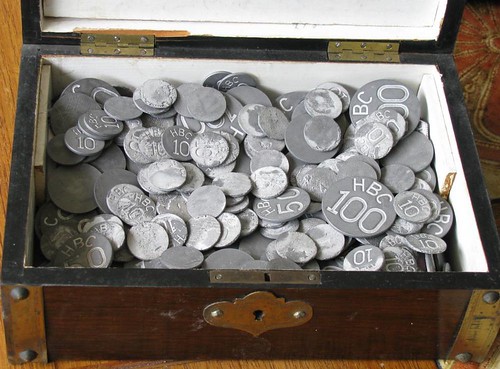
This hoard came out of South Dakota, the seller indicating he had had them for many years. I have dubbed them the "South Dakota Hoard." Even though the Hudson Bay Company did have posts in the Dakotas in the very early years, they were no longer operating in the 1940s, so it is highly unlikely they were used in that area.
This was a large lot with many pieces badly corroded. Surviving this corrosion was (25) 100 Cent, (69) 50 Cent and (27) 10 Cent. There were (125) badly corroded 10 cent pieces. Variances in some of the 50 Cent and 10 Cent pieces have been noticed and will be discussed.
They look a lot like the 1946 aluminum issue with 5, 10, 25, 50 and 100 cent denomination pieces (there were no 5 or 25 cent pieces in the hoard). But comparing them to the known aluminum set from 1946, they are quite different in size and color. They are quite a bit smaller in diameter, and they are darker in color. The lettering also appears to have been painted white.
I did my own comparison analysis from samples sent to me to the known tokens in this series.
A very careful and extensive analysis was performed on these tokens in an effort to determine their authenticity, or conversely, their counterfeit nature! A detailed report was provided to us...
Are these modern day reproductions and hence counterfeits? Since the known set of tokens in the 1946 series can fetch $200-$300 a set, the incentive to counterfeit is there. However, a modern day counterfeiter would make these pieces look more like the original series. Clearly this new discovery is quite different from the known series!
A modern day counterfeiter would not have allowed so many of the 10 cent pieces to become so corroded. These tokens would have been introduced to the collector community a few at a time if counterfeiting was their purpose. These were sold in one lot, something a counterfeiter would not do. For these reasons and the argument for contemporary production posed next, we can clearly discount these as modern day counterfeits.
Are these a contemporary production of HBC tokens? This appears to be the case. HBC tokens were produced for internal use only, that is, between the trader and the Hudson Bay Company and had only value in trade at the store. This means they had no value outside of the HBC, other than to collectors of HBC tokens.
Greg Ingram adds:
The article will be published shortly in CATC and C-4 Token collectors groups in Canada and the US, and I believe The Numismatist will be running it as well. It was published in Canadian Coins News as well over the last few months.
1974 CARSON CITY DOLLAR GSA SALE PRESS KIT SOLD
Len Augsburger noticed this "interesting piece of numismatic ephemera" on eBay this week - a press kit for the U.S. Treasury's 1974 sale of Carson City dollar coins by the General Services Administration.
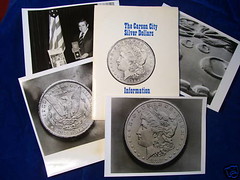 At the time of the first GSA sales, the GSA was not only heavily promoting the GSA sale via their brochures displayed at post offices, banks, and other financial institutions, they put together press kits that were mailed to newspapers across the country.
At the time of the first GSA sales, the GSA was not only heavily promoting the GSA sale via their brochures displayed at post offices, banks, and other financial institutions, they put together press kits that were mailed to newspapers across the country.
So what's this GSA press kit consist of?
The outer folder, measuring 9" X 12", is glossy white with a large picture of an 1884 CC and titled in blue ink, The Carson City Silver Dollars Information. Inside, there's a pocket on each page. On the left are four black and white photographs, each with a description produced by the GSA and each measuring roughly 8" X 10". The four glossy photos include 1) a close up of a CC mintmark 2) a close up of the obverse of an 1882 Morgan Dollar 3) a close up of the reverse of a Carson City Morgan Dollar 4) a photograph of then-GSA Administrator Arthur F. Sampson displaying a GSA CC dollar. Next to him is pictured one of the GSA cardboard displays with the GSA order forms positioned it the display's pocket.
The pocket on the right holds a letter dated May 7, 1974 addressed to Mr. John H. Steele, Managing Editor, Sunday Edition, Trenton Times-Advertiser from Susan Kossin, Regional Coordinator, Carson City Silver Dollar Program. In the letter Ms. Kossin explains the purpose of the press kit and even offers the editor the chance for one of his reporters to interview a government official associated with the sale.
Additionally, the following printed materials, all on GSA CC Sale letterhead are included 1) Last of a Legacy Is Theme of Carson City Silver Dollar Sale 2) GSA to Open 5th Sale of Carson City Dollars 3) Questions & Answers Carson City Silver Dollar Sale "The Last of a Legacy" 4) How to Bid 5) Facts on Sale of Carson City Silver Dollars (not on GSA CC Sale letterhead) 6) GSA News Release #6242
To read the complete lot description, see: Exceedingly Rare GSA CC Sale Press Kit from 1974! (cgi.ebay.com/ws/eBayISAPI.dll?ViewItem&item=220554834990)
DICK JOHNSON: WHY THE U.S. MINT SHOULD CEASE STRIKING CENTS
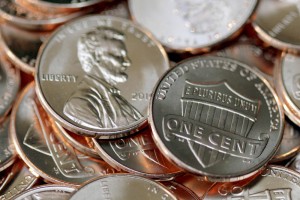 "Goodbye, Lincoln cents." That is what the U.S. Mint should have said this week, rather than "See our new Shield Reverse on the cent!"
"Goodbye, Lincoln cents." That is what the U.S. Mint should have said this week, rather than "See our new Shield Reverse on the cent!"
And not for the reason it is costing 1.8 cents to manufacture each new one cent coin -- although that is a very strong reason. Nor for the reason the zinc industry is bearing down on the Treasury with their lobbying efforts to retain the contract to supply copper-coated zinc blanks to the Mint. Nor for the reason the polls say Americans wish the cent coin should be retained.
Oh! If only cooler heads could prevail in Washington! The reason the cent should be abolished is this: It is no longer viable as a circulating denomination. It is not needed any longer. It no longer serves an economic function.
The U.S. Treasury, while it is dealing in trillions of dollars in payments and taxes, is actually doing a disservice to American citizens by forcing them to use a coin valued at one-hundred-trillionth of that value in millions of transactions every day by every citizen.
By eliminating the cent -- and I propose the five-cent nickel as well -- and rounding off every transaction to the nearest 10-cent amount, thousands of dollars would be saved by banks and large retail establishments for not having to acquire, inventory and handle low value coins. The efficiency would be enormous, as well as saving millions of dollars. I have spoken previously in The E-Sylum refuting every argument in favor of retaining the cent. Such nostalgic action is costing Americans dearly.
Admittedly, a problem does exist with abolishing a coin. What to do with them? And by so doing, you create a coin shortage for the newly important dime. Chicago Federal Reserve Bank Chief Economist Francois Velde came up with a brilliant solution. Velde suggests "rebasing" the cent. He wants each cent coin to be revalued to the value of five cents. This can be easily done by Treasury fiat proclamation.
The coins stay in circulation. There is no coin shortage. There is no mass melting of coins. There is no hoarding of coins. There is no interruption in commerce. There is no problem, other than, perhaps, informing the public every cent coin is now worth five cents and can circulate side-by-side with the nickel. There is a windfall profit for Americans who have a stash of pennies in jars and piggy banks around the house. Each hundred pennies suddenly are worth five dollars in spending power.
Velde's solution is brilliant, but is falling on deaf ears in Washington. Where Velde wants to do this for the cent only, I want it to happen for both the cent and the nickel at the same time. If we did it only for the cent, we would be facing a similar action shortly in the future for the nickel. Best to do it all at once. Make both cents and nickels revalued to 10 cents.
Last week in The E-Sylum I suggested creating a new U.S. Mint for the single purpose of striking new dimes. I estimated this would take 10 years. I see at the end of that time -- when sufficient dimes and half dollars become available -- the cents and nickels could be recalled and scrapped. "But that is going to cost the government 10 cents each for those coins!" you might exclaim. The metal from those coins would provide the metal for new coins whose compositions I outlined in that article.
The metal would provide part of the alloy or cladding for 50-cent through $5 coins. The seignorage would be enormous and cover the cost of buying back all those minor coins at ten cents each.
Velde's proposal was brilliant!
Joe Boling writes:
Regarding Dick Johnson's proposals, I have no problems with rebasing the cent and nickel, and dropping the quarter. But I look on the whole scheme as being no more likely to happen than having the current metallic dollars enter the mainstream. I carry and use them all the time, and have never had one refused, but we all know that as long as paper is around, coins in parallel denominations are not going to fly. Now that the senior senator from Massachusetts is gone, maybe there's a slim hope of getting the dollar note dropped - but I doubt it.
To read the earlier E-Sylum article, see: COMMENTS ON DICK JOHNSON'S OPEN LETTER ON COINAGE (www.coinbooks.org/esylum_v13n07a15.html)
THE 2010 LINCOLN CENT SHIELD REVERSE DESIGN
I do have one question - is this the first time the initials of TWO creators are included on THE SAME SIDE of a U.S. coin? Signing the new Shield Reverse are United States Mint Artistic Infusion Program Associate Designer Lyndall Bass (LB) and United States Mint Sculptor-Engraver Joseph Menna (JFM). -Editor
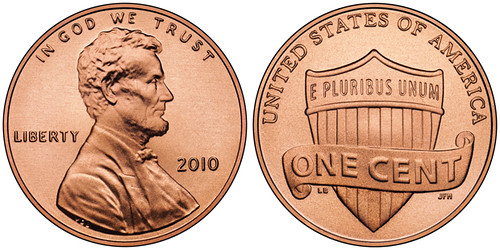
Last week, the mint unveiled 2010's penny--Lincoln on the front, as usual, and a simple shield on the back. Gone is the Lincoln Memorial, maybe the most emotionally and socially charged building in the country. Gone is the wonderful level of detail (remember when you first discovered the tiny Lincoln statue in between the columns?).
Compare it to 27-year-old Matthew Dent's redesign of Britain's coins--the best use of a shield on currency I've seen. Dent's redesign is contemporary but still complex; the coins work alone and as a set. Ours is simplistic and fake-looking. The penny is valueless enough as it is, and a one-dimensional design like this only makes matters worse.
To read the complete article, see: New Penny Designs Make No Cents (www.fastcompany.com/1553660/new-penny-designs-make-no-cents)
THE BOOK BAZARRE
WILLIAM HARNETT, ENGRAVER AND TROMPE L'OEIL PAINTER
Kay forwarded a link to the following scrapbook of information on Harnett. -Editor
Harnett began his career as an engraver in Philadelphia in 1865 at the age of seventeen, working on steel, copper, and wood and eventually becoming an accomplished engraver of silver flatware.
After moving to New York in 1869, he was employed by several silver manufacturers, including Tiffany and Company and Wood and Hughes, where he shared a workbench with Blemly, a fellow engraver. Harnett and Blemly became lifelong friends, and over the years Harnett presented the Blemly family with gifts of engraved sterling; it is through these pieces that Harnett's work as an engraver is known.
Harnett continued working as a silver engraver until 1875, when his still lifes began to sell and his financial success as a painter became more certain.
To read the complete description, see:
Scrapbook
(www.metmuseum.org/works_of_art/collection_database/the_libraries
/scrapbook_containing_newspaper_and_magazine_clippings
_william_ignatius_blemly/objectview.aspx?collID=16&OID=160000161)
Kay adds:
I looked at material on Harnett at the Smithsonian Archives of American Art when doing research for Tiffany & Co. He is just one of many artists (Augustus Saint-Gaudens, etc.) who worked at Tiffany & Co.
Other information on Harnett as a silver engraver is found in an essay "Burin to Brush: Harnett as an Artisan" by Paul Raymond Provost, in the catalog "William Harnett" that accompanied the exhibit on same in 1992 at the Metropolitan Museum of Art.
By the way, Tiffany Studios and Louis Comfort Tiffany should not be confused with Tiffany & Co. which was started by LCT's father, Charles Lewis Tiffany. It's a big distinction which is often not understood.
THE COLLECTORS WEEKLY

The Collectors Weekly recently published a great interview with Dick Doty of the National Numismatic Collection at the Smithsonian. This wasn't their first interview, and more are planned. The site has some equally interesting interviews with U.S. Pattern coin collector Andy Lustig and Liberty Seated Dime collector and author Gerry Fortin (see the link below).
The Collectors Weekly team kindly added a link to our web site, the Numismatic Bibliomania Society (coinbooks.org). Thanks!
To visit the Coins section of Collector's Weekly, see: http://www.collectorsweekly.com/us-coins/overview
To read the earlier E-Sylum article, see: INTERVIEW WITH SMITHSONIAN NUMISMATIC CURATOR RICHARD DOTY (www.coinbooks.org/esylum_v13n06a08.html)
THE BANKNOTE MUSEUM OF GREECE
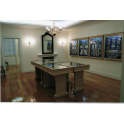 The Ionian island of Corfu, home of the mythical Phaiakes, or Phaeacians, one of a race of people inhabiting the island of Scheria (identified with present-day Corfu) visited by Odysseus on his way home from the Trojan War, is home to the Banknote Museum of Greece, the only one of its kind in Greece and one of the very few in the world, with a comprehensive and continuously expanding collection.
The Ionian island of Corfu, home of the mythical Phaiakes, or Phaeacians, one of a race of people inhabiting the island of Scheria (identified with present-day Corfu) visited by Odysseus on his way home from the Trojan War, is home to the Banknote Museum of Greece, the only one of its kind in Greece and one of the very few in the world, with a comprehensive and continuously expanding collection.
The Banknotes Museum is housed on the first floor of the preserved building that was the first branch of the Ionian Bank (now Alpha Bank) in Corfu, and showcases a near-complete collection of Greek banknotes, from the very first ones circulated in 1822 to the last ones withdrawn in 2002 with the advent of the euro, sketches, essays and printing plates for various Greek banknotes, archive material (documents, accounting books, checks, photographs relating to the history of the Ionian Bank), and a complete series of the last issues of the national banknotes by the euro-zone member states before their replacement by the single currency, the euro, as well as a reproduction of the modern manufacturing process of banknotes. The collection numbers more than 2,000 items.
The Banknotes Museum contains historical material pertaining to the history of the Ionian Bank and a complete series of the last issues of the national banknotes of the eurozone states prior to replacement by the euro. The manufacturing process of banknotes is included among the exhibits as well as the method of adding a watermark, while a workshop details the metal plate engraving process.
The Banknotes Museum's collection is considered one of the most complete of its kind in the world, and includes the first treasury bonds issued by the newly-liberated Greek State in 1822 up until the replacement of the national currency, the drachma, by the euro in 2002.
The exhibits include some rare specimens of Greek currency, including the 1860 "colonata".
One of the rarest banknotes on exhibit is one depicting the Byzantine church of Aghia Sophia in Constantinople, designed in 1920, without the Ottoman minarets, but it was never circulated since the Asia Minor disaster occurred only a few years later.
Also on display are the first banknotes issued by the first Governor of Greece Ioannis Kapodistrias, featuring a rose colored phoenix on a white background, while the collection also contains the pre-Kapodistrias treasury bonds issued by the provisional Greek government in "grossia" (or pisters).
With the establishment of the National Bank of Greece in 1841, the ancient drachma once again became the official currency of Greece. On display are the first banknotes printed by the British printing houses Perkins Bacon and Bradbury Wilkins, followed by the American Banknote Company that succeeded the British at the turn of the century, which printed Greek banknotes up to about 1982, when the Bank of Greece undertook the printing of the country's currency.
To read the complete article, see:
Banknotes Museum of Corfu: A sojourn through Greece's economic history
(www.ana.gr/anaweb/user/showplain?maindoc
=8380929&maindocimg=7918831&service=144)
THE BOOK BAZARRE
ANCIENT COIN COLLECTORS GUILD SUES U.S. GOVERNMENT
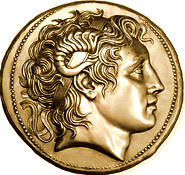 U.S. Customs agents refuse to return 23 ancient coins they seized unfairly - some from Cyprus, where coins were minted by Alexander the Great, the Ancient Coin Collectors Guild claims in Federal Court. The Guild says Customs unfairly and arbitrarily applies import restrictions on historical coins, which have been traded for centuries and are of moderate value because there are so many of them.
U.S. Customs agents refuse to return 23 ancient coins they seized unfairly - some from Cyprus, where coins were minted by Alexander the Great, the Ancient Coin Collectors Guild claims in Federal Court. The Guild says Customs unfairly and arbitrarily applies import restrictions on historical coins, which have been traded for centuries and are of moderate value because there are so many of them.
Of the 23 coins seized, Customs reported that three were knife-shaped, seven were from Cyprus and 12 from China.
The Guild says Customs seized the coins because it could not "establish a chain of custody beyond receipt from a reputable source."
"Historical coins have actively been traded for at least 500 years as collectibles. Due to their usual modest value and the huge numbers extant, historical coins are typically traded without any provenance information or documentary history as to where and when they were found," the Guild says.
The Missouri-based Collectors Guild says it bought the coins in London and its broker sent them to Baltimore, where Customs seized them.
The group says Customs refuses to file a forfeiture action for the coins, which the Guild values at $275.
The Guild sued Customs and Border Protection, the Department of Homeland Security and the Department of State for arbitrarily applying import restrictions on ancient coins, and violating the Fifth Amendment by taking the coins without filing a forfeiture action. It wants the court to declare the restrictions illegal, and it wants the coins back.
To read the complete article, see: Ancient Coin Collectors Guild Says Uncle Sam Seizes Coins Arbitrarily (www.courthousenews.com/2010/02/15/24687.htm)
OLD SILVER RUPEE COINS STILL USED IN MYANMAR ENCLAVES
I've heard segments in this reporter's series, but missed the coin reference. He's reporting on his travels down the Mekong river. -Editor
 In an Akha village halfway between the Mekong and the market town of Kengtung, the dogs are suspicious, but the people are friendly. The dozen or so houses are the same simple wooden structures the Akha have built for generations.
In an Akha village halfway between the Mekong and the market town of Kengtung, the dogs are suspicious, but the people are friendly. The dozen or so houses are the same simple wooden structures the Akha have built for generations.
"Twenty or 30 years ago, many Akha were still animists, and in our community, if a mother gave birth to twins, it was considered bad luck," he says.
It signaled such bad luck that newborn twins would often be killed, he and others in the village say, by putting ashes in their mouths. If the families refused, they would be forced out of the village.
My guide, who goes by the name Freddy, explains that when the British arrived in the Kengtung area, they used rupee coins to buy opium from the local hill tribes.
"Nowadays, these people, they still believe this coin. They believe it because it's silver and they can keep them easy. If you buy animals from them, like cow or buffalo or the land, we have to buy with this coin. They don't want the Myanmar currency," Freddy says.
To read the complete article, see: Mekong Flows Along Troubled Myanmar's East (www.npr.org/templates/story/story.php?storyId=123570472)
CINCINNATI GOLD EXHIBIT
 The Cincinnati Museum Center is experiencing a gold rush.
The Cincinnati Museum Center is experiencing a gold rush.
A new exhibit is full of hundreds of pieces of jewelry, war medals, coins and bars, reported ONN's Lot Tan.
"Everything here is gorgeous. It's just exquisite," said Jane MacKnight of the Cincinnati Museum Center.
The show includes a gold room, where ultra thin sheets of gold line the walls.
Plus, there are gold coins and bars.
One bar is 63 pounds of pure gold, which is a hefty treasure considering gold is trading at more than $1,000 an ounce these days.
"Cincinnati played a prominent role in so many areas and gold was one of them," said David Conzett of the Cincinnati Museum Center.
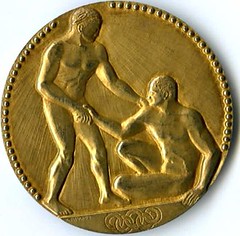 Cincinnati native William DeHart Hubbard was the first African-American to win gold in an individual Olympic event. He captured the medal in long jump at the Paris games in 1924. That medal is on display.
Cincinnati native William DeHart Hubbard was the first African-American to win gold in an individual Olympic event. He captured the medal in long jump at the Paris games in 1924. That medal is on display.
A war hero's medal is on display as well. Gen. William Lytle was killed in the Civil War, but not before receiving an elaborate gold medal.
To read the complete article, see: Gold Exhibit Shines In Cincinnati (www.10tv.com/live/content/onnnews/stories/2010/02/18/story-Discover_Ohio_Gold.html)
Here's another article - this one has images:
All that's glittering at Museum Center is gold
(news.cincinnati.com/article/20100205/ENT07/2050301/
All-that%5C-s-glittering-at-Museum-Center-is-gold)
SOUTH CAROLINA LEGISLATOR WANTS TO OUTLAW FEDERAL RESERVE NOTES
South Carolina will no longer recognize U.S. currency as legal tender, if State Rep. Mike Pitts has his way.
Pitts, a fourth-term Republican from Laurens, introduced legislation earlier this month that would ban what he calls "the unconstitutional substitution of Federal Reserve Notes for silver and gold coin" in South Carolina.
If the bill were to become law, South Carolina would no longer accept or use anything other than silver and gold coins as a form of payment for any debt, meaning paper money would be out in the Palmetto State.
Pitts said the intent of the bill is to give South Carolina the ability to "function through gold and silver coinage" and give the state a "base of currency" in the event of a complete implosion of the U.S. economic system.
"I'm not one to cry ‘chicken little,' but if our federal government keeps spending at the rate we're spending I don't see any other outcome than the collapse of the economic system," Pitts said.
But one legal expert told The Palmetto Scoop that, even if it were passed, Pitts' bill would quickly be ruled unconstitutional.
"It violates a perfectly legal and Constitutional federal law, enacted pursuant to the Commerce Clause of the U.S. Constitution, that federal reserve notes are legal tender for all debts public and private," the expert said. "We settled this debate in the early 1800s. I appreciate the political sentiment but the law is blatantly unconstitutional."
The article drew over 130 web site comments. You gotta love the ability for everyone and anyone to chime in on a topic. Long live Free Speech. Here are a couple good ones, one both sides of the issue:
-Editor
To read the complete article, see:
PITTS INTRODUCES LEGISLATION TO REPLACE PAPER MONEY WITH GOLD, SILVER COINS
(www.palmettoscoop.com/2010/02/17/
bill-would-ban-federal-currency-in-sc/)
THE ONION: NATION REALIZES MONEY JUST A MUTUALLY SHARED ILLUSION
On a related note, Loren Gatch writes:
You might want to use this nice piece from this week's The Onion: "U.S. Economy Grinds To Halt As Nation Realizes Money Just A Symbolic, Mutually Shared Illusion".
I particularly like President Obama muttering about his coin collection, "it's just metal, it's just metal"...
 The U.S. economy ceased to function this week after unexpected existential remarks by Federal Reserve chairman Ben Bernanke shocked Americans into realizing that money is, in fact, just a meaningless and intangible social construct.
The U.S. economy ceased to function this week after unexpected existential remarks by Federal Reserve chairman Ben Bernanke shocked Americans into realizing that money is, in fact, just a meaningless and intangible social construct.
What began as a routine report before the Senate Finance Committee Tuesday ended with Bernanke passionately disavowing the entire concept of currency, and negating in an instant the very foundation of the world's largest economy.
"Though raising interest rates is unlikely at the moment, the Fed will of course act appropriately if we…if we…" said Bernanke, who then paused for a moment, looked down at his prepared statement, and shook his head in utter disbelief. "You know what? It doesn't matter. None of this—this so-called 'money'—really matters at all."
"It's just an illusion," a wide-eyed Bernanke added as he removed bills from his wallet and slowly spread them out before him. "Just look at it: Meaningless pieces of paper with numbers printed on them. Worthless." According to witnesses, Finance Committee members sat in thunderstruck silence for several moments until Sen. Orrin Hatch (R-UT) finally shouted out, "Oh my God, he's right. It's all a mirage. All of it—the money, our whole economy—it's all a lie!"
Screams then filled the Senate Chamber as lawmakers and members of the press ran for the exits, leaving in their wake aisles littered with the remains of torn currency.
A few U.S. banks have remained open, though most teller windows are unmanned due to a lack of interest in transactions involving mere scraps of paper or, worse, decimal points and computer data signifying mere scraps of paper. At a Bank of America branch in Spokane, WA, curious former customers wandered aimlessly through a large empty vault, while several would-be robbers of a Chase bank in Columbus, OH reportedly put their guns down and exited the building hand in hand with security guards, laughing over the inherent absurdity of the idea of $100 bills.
To read the complete article, see: U.S. Economy Grinds To Halt As Nation Realizes Money Just A Symbolic, Mutually Shared Illusion (www.theonion.com/content/news/u_s_economy_grinds_to_halt_as)
FEATURED WEB SITE: THE COINS OF MALTA
This week's Featured Web site on the coins of Malta is suggested by Bill Synder.
Following the Roman conquest, the Maltese Islands were apparently allowed a limited measure of self-government, including the privilege of minting their own coins. The Maltese coins of that period were all circular and struck in bronze, the only metal the Roman authorities permitted to be coined in the Sicilian municipia. These autonomous issues circulated alongside the official currency of the Roman Republic which consisted of gold, silver and bronze coins.
The exact date of the first locally struck coin is not known but it is likely to have been after 212 B.C. when Sicily became a Roman province (with the Maltese Islands being incorporated into it) and was given the right by Rome to mint its own coinage in 211 B.C.
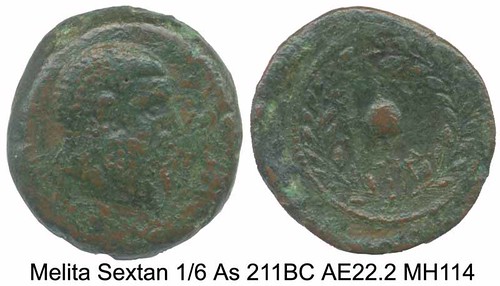
coins.mos.net.au/firstpage.htm
